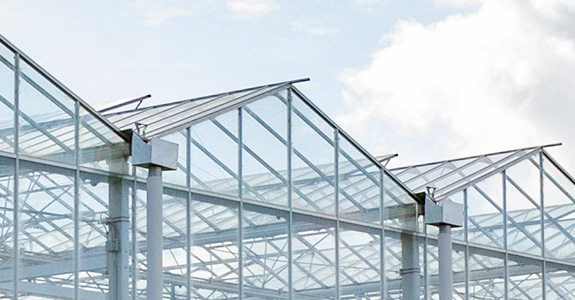How to select the right greenhouse covering for your business
Whether you're just starting, looking to expand, or considering alternatives to your current greenhouse covering, we want to help you make an informed decision. You should consider such factors as the unique risks you face, cost, the climate where you operate, and what crops you grow.
Let's review the top risks that impact greenhouse covering and explore the advantages and disadvantages of the most common coverings to help you select the one that best suits your business.
Top risks for greenhouse coverings
No matter the type of covering you choose, there are major risks that can impact its integrity, including:
Wind: Sustained high winds and wind gusts are the primary causes of damage to coverings.
Hail: While there's little you can do to prevent hail from hitting your greenhouse, you can help reduce hail-related losses involving your greenhouse.
Debris: Loose items around your property can be picked up by high winds and blown against your greenhouse covering, causing tears or broken glass. Here are some tips to help keep your property tidy.
Trees: Most tree damage to coverings is due to wind, but even healthy trees pose a risk of dropping limbs on your structures.
Birds: Birds can tear holes in your covering and fly into your structures.
Cold temperatures: Frigid conditions can weaken the integrity of older plastic covering, as condensation freezes and then thaws.
Snow and ice: If you allow snow and ice to build up on your covering, the weight of the load can lead to a collapse.
The age of your greenhouse covering plays a role on the impact of some of the risks listed above. As your covering ages, it becomes less durable. Review the manufacturer recommendations for the life span of your covering and consider replacing it as needed.
Pros and cons of different types of greenhouse covering
Each of the following types of popular greenhouse covering vary in cost, durability, and risks. Take into account your budget, climate, and what crops you're growing when deciding which covering to use.
Plastic film (polyethylene) greenhouse covering
A plastic covering might be a good option for you if you're starting your operation or looking for a more cost-effective solution. It's the cheapest and easiest option to install. Plastic is also an excellent light diffuser and does a good job of retaining heat.
One disadvantage of plastic is its short life span, which means you may have to replace your covering every few years. Plastic is also susceptible to tearing due to ultraviolet (UV) radiation and air pollution. Both break down plastic components, making them more likely to fail over time.
Polycarbonate greenhouse covering
Polycarbonate is a more rigid plastic greenhouse covering that provides good insulation and durability against hail and birds. On average, polycarbonate also holds up well against UV radiation and air pollution damage, leading to a longer life span.
On the flip side, polycarbonate is more expensive than plastic and is more prone to discoloring, affecting the amount of light that gets through. Depending on your location and how rainy or humid it gets, you might also have to monitor algae growth with this option.
Glass greenhouse covering
A glass covering provides the best light transmission and has a better thermal rating compared to the other types of greenhouse coverings listed here. This covering also has the longest life span and is non-combustible.
Glass is a more expensive option than the other coverings listed here, especially for initial construction, because it needs additional supporting materials during installation due to its weight. Glass is also the most vulnerable to hail, flying objects, and birds.
Also, keep in mind that single-pane glass options aren't ideal for northern climates, as they provide poor insulation and aren't manufactured to handle weight-bearing loads such as snow.
Fiberglass greenhouse covering
A fiberglass covering is durable and cheaper than glass and polycarbonate options. This is a good option if you're located in states more susceptible to hail, such as Nebraska and Oklahoma.
The disadvantages of fiberglass covering include vulnerability to sun exposure—where UV rays can break down its components, leading to discoloration and a shorter lifespan.
Insurance providers can help you
Use this information in this article to help you choose the right greenhouse covering for your business. You can also ask your insurance company for guidance. Insurance providers like us have the experience and knowledge to assess risks horticultural businesses like yours face, including risks that could impact your greenhouse covering.
If you have questions or would like to learn more about how we can help with your greenhouse covering and greenhouse operation, contact us. We're here to help you keep your crops and assets safe.
Related links:
Check out the top risks for horticultural businesses like yours and learn about the insurance coverages that can help protect you.
If you suffer damage to your greenhouse or greenhouse covering, you need to file a claim. Here are five tips for reporting a claim to help get your claim started, processed, and settled more quickly.
Learn how taking a proactive safety approach can help improve your business operations and your bottom line.
The information in this article is for informational or entertainment purposes only. View our disclaimer by going to terms and conditions and clicking on Learning Center disclaimer in the table of contents.
